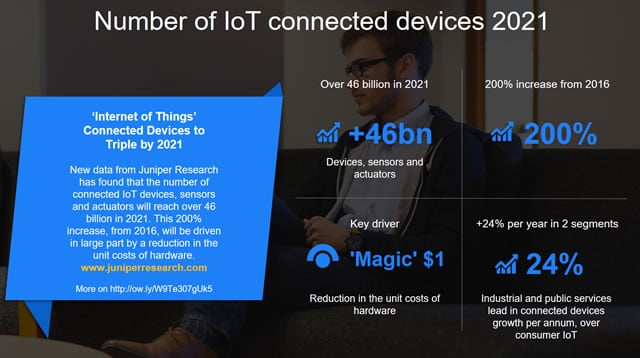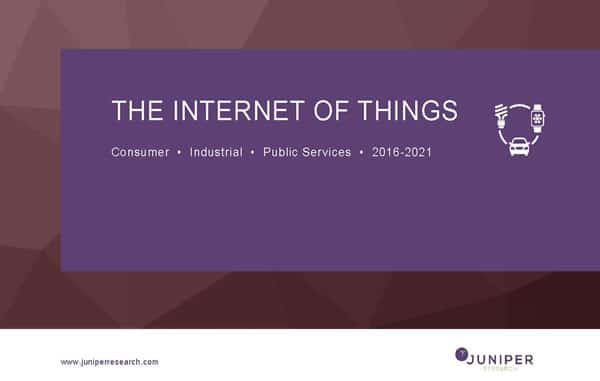There is one area where we never will come up with predictions or forecasts in terms of numbers: the Internet of Things (IoT) and, more specifically the number of IoT-enabled or IoT-connected devices.
Not even that long ago predictions regarding the number of connected devices often reached 50 – 100 billion units by 2020. In some cases that wasn’t enough and forecasts went well over 100 billion connected devices with even an occasional trillion here and there (we are not kidding).
The number of connected IoT devices, sensors and actuators will reach over 46 billion in 2021 (Juniper Research, December 2016)
At the end of 2016, the picture looks quite different. Estimates range somewhere between 20 and 30 billion connected devices by 2020 and still, we have to be careful. Part of the revised forecasts (never going up, always down) is due to market evolutions, part is certainly due to hype and, let’s face it, larger IoT solution providers do have an impact on analyst forecasts.
Triple growth of IoT-connected devices between 2016 and 2021
From the perspective of a consumer or a business executive who wants to deploy a smart solution, based upon the Internet of Things, to improve part of his business, the number of connected devices doesn’t matter of course. Yet, to many others it does.
So, anywhere between 20 and 30 billion by 2020. We’ll see by then what the ‘real’ numbers are. On December 2016, another research firm posted predictions of the number of connected Internet of Things devices that go well above 30 billion.
Juniper Research found that the number of connected IoT devices, sensors and actuators (important terms for comparison purposes) will triple to over 46 billion.
However, it’s not by 2020 but by 2021. The 200% increase, from 2016, will be mainly driven by the reduced IoT hardware costs, Juniper Research claims.

The fastest growing categories of connected devices are not in the consumer space
Yet, the forecasted growth of connected devices is not for the Consumer Internet of Things, even if the ‘magic’ $1 throughout the forecast period will be close as Juniper puts it (and cost is a consideration, on top of many others, for consumers too).
The research, entitled “The Internet of Things: Consumer, Industrial & Public Services 2016-2021” and thus obviously looking at the Consumer Internet of Things (CIoT), industrial IoT (IIoT) and the usage of IoT in public services found that the latter two will post the highest growth over the forecast period, with an annual average of over 24 percent growth.
Both providers and end-users will face tremendous challenges when considering IoT deployments at scale (Juniper Research, December 2016)
In other words: the number of connected IoT consumer devices which we recently tackled, based upon a December 2016 IAB report, is going to grow slower than connected devices in industrial and public services. Still, all in all impressive growth ahead but we’re not there yet.
The research looks at more than just the number of connected devices as we’ll cover later. You can of course also buy the report or check out some more findings in the press release.
Last but not least, there is also a whitepaper, entitled ‘IoT – Internet of Transformation’ with more details about the research and available for download.


